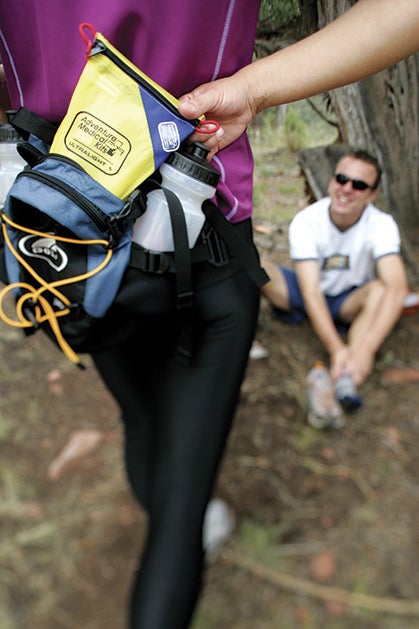Wilderness 911

Vital first aid when you’re hurt in the dirt
Photo by David Clifford
Autumn in north Georgia is pristine. The cool, occasionally chilly air, vibrant colors bursting from all directions and the rhythmic crunch of leaves under foot make it an idyllic setting for a long trail run. On just such a day, Linda Sledge and her husband settled into a peaceful escape from the rest of the world.
SNAP! One flying stride over a fallen tree trunk quickly brought Linda back to reality. Her ankle had given way, and a surge of pain overcame her as she rolled to the ground. Still a few miles from the end of their 23-mile outing, the pair had nothing but a couple of water bottles. And Linda could hardly stand, let alone walk.
Fortunately, thanks to common sense, quick action and Linda’s notably high pain threshold, this story ends happily. After assessing the situation, Linda immersed her ankle in a nearby stream to reduce the swelling, then used sticks and branches as a makeshift crutch enabling her to hobble to safety.
One spiral fracture and a year’s worth of rehabilitation later, Linda is once again running the trails—now carrying a small first-aid kit.
A Dose of Preparation
OK, maybe it’s not realistic to expect all trail runners to tote along a first-aid kit. And, granted, a first-aid kit might not handle every eventuality. But when a trail emergency arises, you should know what to do.
“Prevention is absolutely the best approach to trail safety,” says Dr. Dennis Kerrigan, a long-time lead instructor for Wilderness Medical Associates, a Maine-based institute that provides medical training to outdoor professionals and rescue specialists. “People think that simply bringing a cell phone or first-aid kit means they’re good to go, but no piece of equipment can replace good judgment or assessment and evaluation skills.”
Kerrigan cites dehydration, sprains, fractures and falls as the most common trail injuries—the majority of which, he emphasizes, could be avoided with a little extra preparation and the willingness to carry an extra water bottle or a small aid pack.
Here are a few rules of thumb to help even the most diehard minimalist handle and prevent difficulties on the trail:
Leaner and lighter isn’t always better. There’s no need to load up like a Sherpa, but tossing a mini first-aid kit into your pack will provide the tools necessary for cleaning and protecting basic wounds or wrapping a simple sprain. For longer distances, Kerrigan recommends bringing a soft splint to stabilize a potential fracture. You can purchase a simple aid kit online at adventuremedicalkits.com. Also, SAM Medical products sells lightweight, easy-to-carry splints and slings (www.sammedical.com).
Duct tape also comes highly recommended. “If you take only one other item besides a water bottle, make it a length of duct tape,” says orthopedic surgeon and wilderness medicine practitioner Dr. Bruce Davidson. “Wrap some around your water bottle or a broken off pencil that you can put in your pocket. It weighs very little, and you can use it to stop a blister, cover a wound, tape an ankle or wrist, make a sling or even couple it with sticks to create a temporary splint.”
You can’t dress a wound with a cell phone. Cell phones are fine for the urban jungle, but not a reliable lifeline in the middle of nowhere. Carry one with you, by all means, but even if you’re in range, know how to provide on-the-spot help until medical assistance arrives.
Calmness prevails. Regardless of a situation’s magnitude, stay as calm as possible. Focus on using common sense and making practical decisions that do not increase or exacerbate existing injury or risk.
Use the buddy system. While nothing equals the solitude and peace of a long solo outing, the further afield you go, the more important it becomes to go with a partner. If you must go it alone, be sure to leave a note outlining the specifics of your outing, including departure time, when you plan to return and intended route (make sure you stick to that plan as closely as possible).
This article originally appeared in our March 2006 issue.